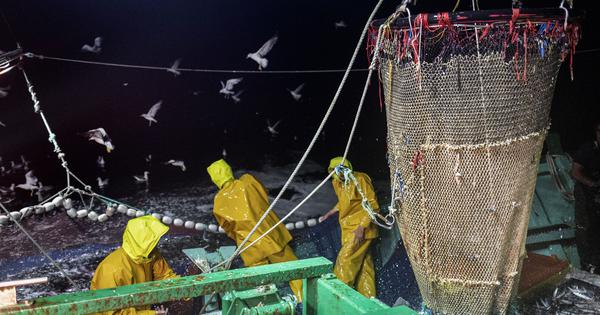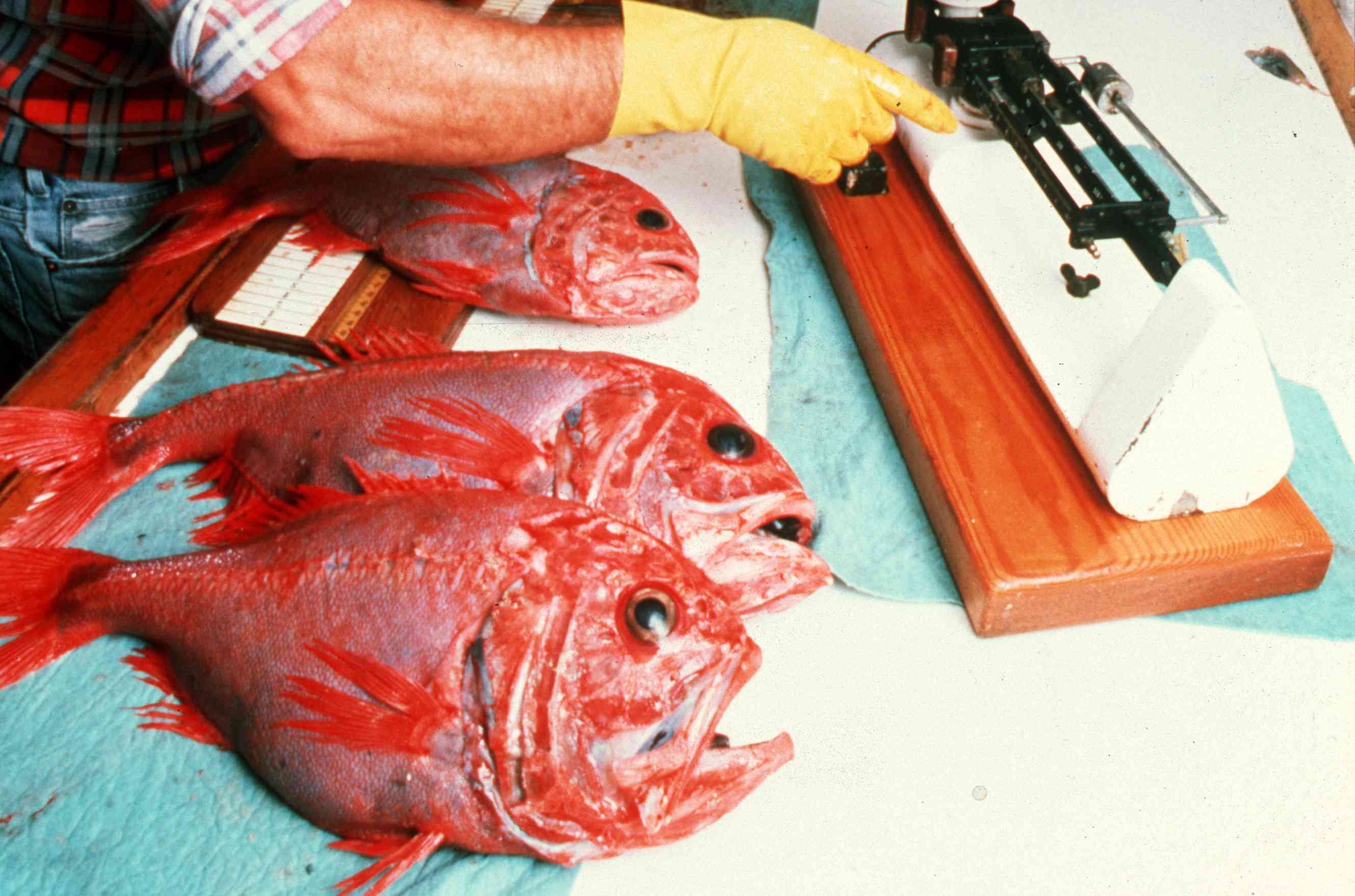
Down in the deep, dark South Pacific Ocean live grouchy-looking, sluggish fish. Some of them have been around since the Qing Dynasty ruled China and possibly even before the United States was an independent country.
With a life expectancy of up to 250 years, orange roughy live slowly. They reach maturity in their late 20s and early 30s when they can gather and breed mostly on seamounts at depths of 800-1,600 metres.
Their unhurried lifestyle was largely undisturbed until the late 1970s, when humans began catching them with deep-sea trawl gear. Since then, orange roughy numbers have plummeted. Bottom trawling, the primary method for harvesting the species, is infamous for its destructive impacts on seabed communities. It also involves high levels of “bycatch” – the capture of non-target animals.
These days, bottom trawling and the use of deep-sea resources more generally are both facing growing scrutiny, ranging from the cinema-going public to international negotiators.
The stay-or-go debate over orange roughy fisheries encapsulates the tensions in the relationship between humans and the deep sea.
Deep fishing, deeply damaging
The orange roughy population in part of the largest fishery is now “significantly below” sustainable levels, with only between 8% and 18% of its pre-fishing biomass remaining, according to recent study by the New Zealand government.
For context, Earth Sciences New Zealand (previously the National Institute of Water and Atmospheric Research) states that a biomass level below 20% represents an overfished stock, and one below 10% is deemed to be “collapsed” and at risk of not recovering.
As such, the fish may take decades or even centuries to replenish its populations, given its slow growth and maturation.
Conservationists also say the fishing causes huge damage to seabed ecosystems, especially on the seamounts where the fish likes to spawn and feed, as trawl nets also scrape up corals and sponges that are known to live for over 10,000 years.
“One pass of a trawl net can do significant damage,” says Karli Thomas from the Deep Sea Conservation Coalition. “As few as 10 trawls can leave just a field of rubble. That’s a private gain on the basis of an environmental destruction that affects everybody.”
Bottom trawling targeting orange roughy dragged 112.7 tonnes of coral between 2007/08 and 2019/20, a report commissioned by the New Zealand government shows.
Bottom trawling in general can be destructive regardless of the fish being targeted. In 2024, an unnamed bottom trawling vessel pulled up six tonnes of protected stony coral from a fishing ground, where orange roughy, hoki, hake and other species are fished, according to data obtained by the Deep Sea Conservation Coalition from the New Zealand government.
New Zealand exports most of its orange roughy catch, keeping only a small amount for local consumption. In 2024, these exports were worth NZD 55 million ($31 million), according to NZ Stats.
Its largest export markets are the US and China. The US usually takes the frozen fish fillets, while the whole fish goes to China.
The fish is usually served on middle-class dining tables, says Thomas. “No one is starving for the lack of an orange roughy meal. It’s not going to people where food security is an issue.”
The Deep Sea Conservation Coalition says the New Zealand government must end bottom trawl fishing on seamounts in New Zealand and the South Pacific. But fishers in New Zealand, who capture 80% of the global orange roughy catch, refuse to retire their nets.
‘This keeps us in business’
“Part of our job is to keep the fisheries open,” Charles Heaphy, resources manager at Sealord Group, a New Zealand seafood company, tells Dialogue Earth.
The fishing industry data shows New Zealand’s deep-water fishing contributes NZD 2.7 billion ($1.6 billion) to the economy and supports around 8,500 full-time jobs. Sealord holds the largest orange roughy fishing quota within New Zealand’s exclusive economic zone (EEZ). It also partly controls one of the few firms still bottom trawling for the species in the international waters of the South Pacific.
Heaphy says fishing firms have “good reasons to keep access to these fisheries”.
Only a tiny fraction of the New Zealand EEZ and the South Pacific allows bottom trawling, he notes. In the last three years, orange roughy accounted for 2.4% of the weight of Sealord’s domestic New Zealand catch, Heaphy says. “But that’s really, really important to keep us in business.”
Apart from orange roughy and other white fish, the company also catches low-value fish that are directly sold to Africa, he adds. These fisheries often just break even, and the company relies on fishing orange roughy and other higher-value fish to stay afloat, he says.
But whether the orange roughy fishery can be considered sustainable is an increasingly debated point.

A boom and a bust
For most of history, commercial fishers did little work at depths below 400 metres from the surface.
But the former Soviet Union’s discovery in 1969 of slender armorhead on the Hawaiian-Emperor seamount chain marked a drastic shift. The next year, they trawled up nearly 150,000 tonnes of the greyish deep-sea creatures.
In 1979, the discovery of large numbers of spawning orange roughy on the Chatham Rise, an area of ocean east of New Zealand’s South Island, led to a rush for the pale-fleshed fish, which are valuable enough that they were sometimes called “white gold” in the country.
There were so many fish that trawls could catch 10 tonnes per minute and end up throwing some away or even bursting their nets, according to the UN’s Food and Agriculture Organization.
A crash was to come.
Plummeting population
Chatham Rise is home to the world’s oldest and largest orange roughy fishery. Over 60-70% of New Zealand orange roughy catches are from the rise – particularly the “East and South” area.
In 1997, scientists studied the stock reduction in the north-eastern part of the rise and discovered only 20% of the pre-fishing biomass was left. Catches dropped from over 50,000 tonnes in 1989 to fewer than 20,000 tonnes in 1994 and some of the New Zealand orange roughy fishing grounds closed as a result. That includes the Spawning Box, an important spawning area, which was closed in the early 1990s, and seamount “Morgue” which has been closed to bottom fishing since 2001.
For those that remained open, the New Zealand government significantly reduced the amount fishers were allowed to catch.
“Those mistakes of 40 years ago still haunt us,” says Heaphy. He is referencing a past lack of knowledge on orange roughy’s reproductive cycles and limited stock assessment technology. These blinded regulators and fishers, he says. “From my perspective, we’ve got to put that behind us.”
After the crash in the 1990s, the industry heavily invested in building a sustainable reputation. Since then, the stock decline has stabilised and even shown signs of recovery at times, albeit remaining far below historic levels.
In 2016, three orange roughy fisheries in the country, including Chatham Rise’s Northwest, and East and South areas, earned the Marine Stewardship Council (MSC)’s badge of sustainable fishing. The certification organisation framed this as an “extraordinary turnaround”.
But environmental groups were not convinced, with WWF warning that the decision risked “irreversible, harmful consequences”. Two years ago these fears seemed to have come true.
Another collapse
The New Zealand government sets an annual fishing quota for orange roughy by assessing its stocks regularly. In 2023, research on the species’ stocks sounded an alarm. Once again, concern was focused on Northwest and East and South Chatham Rise.
Computer models used by scientists predicted that the stock on these parts of the rise should be increasing. But data on actual fishing rates and acoustic surveys of fish underwater suggested this was not the case, an official report published in 2024 shows.
The government stock assessment requires computer modelling on top of acoustic surveys and fishing rate data. But because of the substantial inconsistency in the data, it removed the stock status of East and South Chatham Rise. The removal then forced the industry to self-suspend its MSC sustainable status.
Researchers tried again this year to understand how many fish were left in east and south of the rise – only to discover the alarming statistic about stocks being “significantly below” sustainable levels.
Heaphy says “doing a lot of science then finding that the abundance of this one part of a fishery has declined is good fisheries management”. His group already had an “inkling” that the stock was declining and made a precautionary reduction in catch in 2023, he says.
“We are still learning, and it is still not perfect, but we improve at every assessment cycle.”
Sealord only bottom trawls on the seabed that has been trawled before and says this limits additional damage to habitat.
“We’re very careful not to fish in places where we’re going to damage the bottom. We are not expanding [the fisheries]. We go back to the same place… because we can fish in those places without breaking our nets or hitting corals,” he says.
Thomas disagrees. She cites recent research on the Morgue seamount off New Zealand, showing that after being closed to bottom trawling for nearly two decades there were signs of coral recovery.
“We shouldn’t just be writing off certain areas [that had been trawled before] and saying: ‘Oh, it’s trash’,” she says.
“The shocking state of New Zealand’s main orange roughy fishery on the Chatham Rise – once the largest population of this ancient species globally – lays bare the failure to learn the lessons from two decades ago,” she says.
The previous stock assessments up to 2021 were “unreliable and overly optimistic”, she adds.
Fisheries New Zealand, under the Ministry for Primary Industries (MPI), opened a public consultation in July on the next step for East and South Chatham Rise. Closing the fishery for recovery was on the table, as was reducing the catch quotas by 23%, 42% or 60%.
Heaphy says Sealord advocates for the lowest possible catch limit in the area “to keep up data collection.” Whereas Thomas’s group backs a closure but worries even such a step could be too late.
Challenging the government’s previous decision, litigation group Environmental Law Initiative took the minister for oceans and fisheries to court in 2024, arguing the government should have taken a more precautionary approach. Tess Upperton from the group says she hopes the case could make decision-making in fisheries more precautionary.
The new fishing year will begin in October and a decision on the quota is likely to be announced by then.
Regina Lam is an ocean and special projects assistant editor at Dialogue Earth, based in London.
This article was originally published on Dialogue Earth under the Creative Commons BY NC ND licence.
📰 Crime Today News is proudly sponsored by DRYFRUIT & CO – A Brand by eFabby Global LLC
Design & Developed by Yes Mom Hosting






